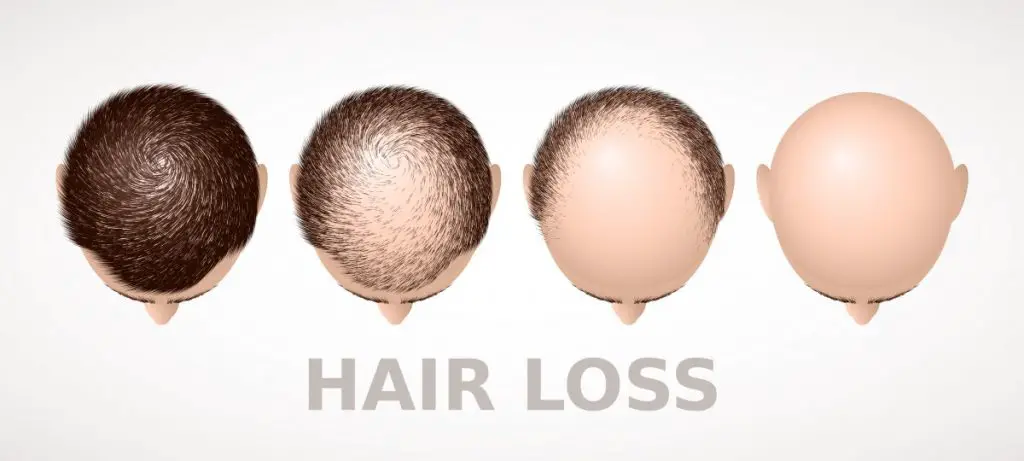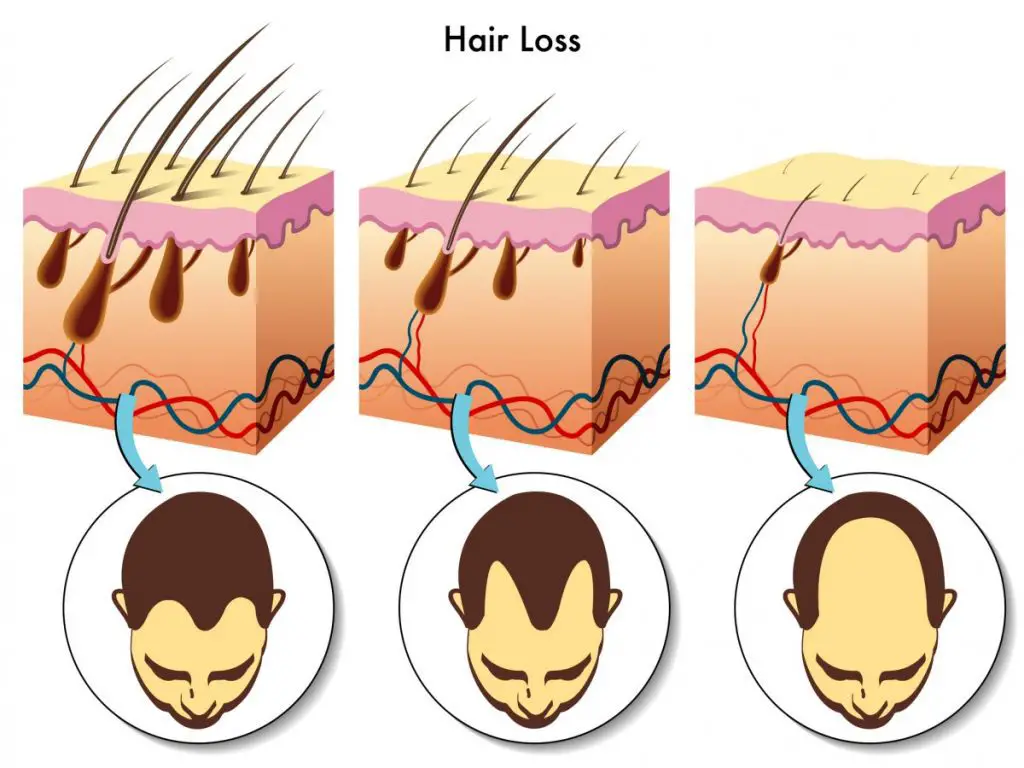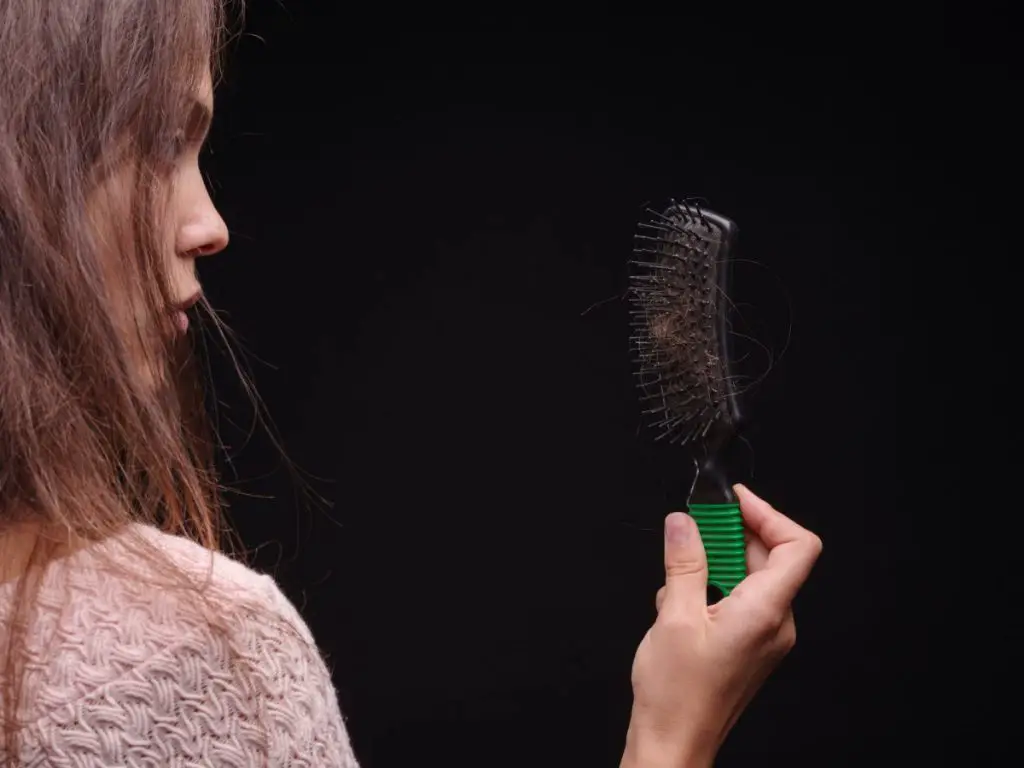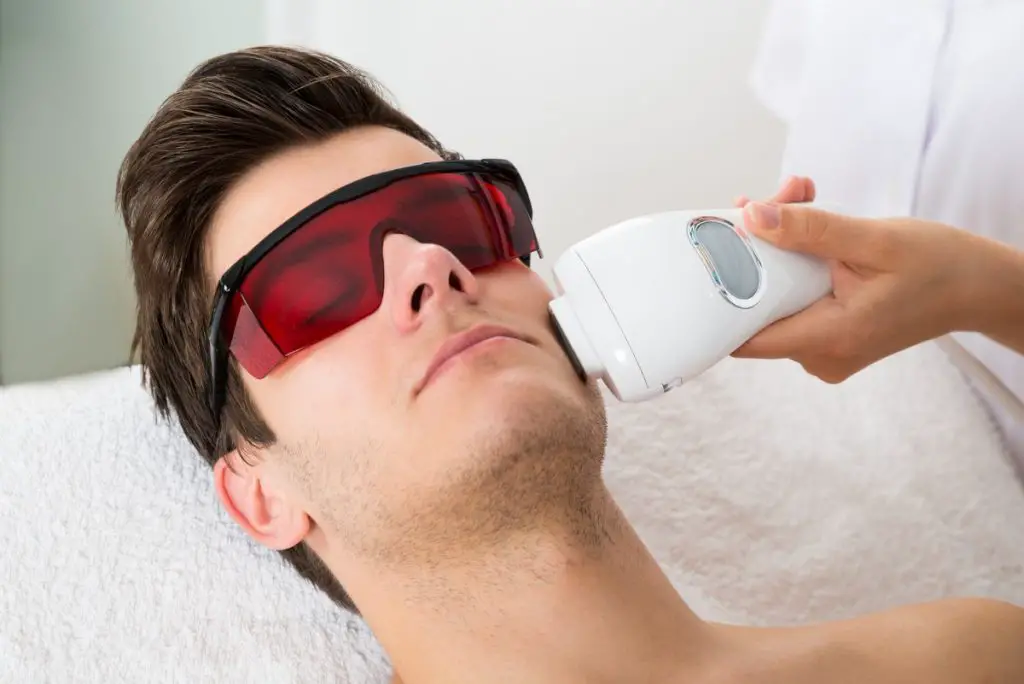
Balding is a common occurrence, but there are some early signs and in some cases, ways to prevent it. Balding may seem unavoidable, as it happens to so many men and women. Those affected by it may use many popular products in an attempt to slow down the process. Many wonder, can balding truly be prevented?
What are the early signs of balding, and how is it prevented? Many types of hair loss are first noticeable with common signs such as a receding hairline and thinning of hair. Some types of hair loss are preventable, but the most common types – male and female pattern baldness – are not.
Over half of men over the age of 50 will experience pattern baldness. Because it is genetic, pattern baldness is not preventable. However, there are some other conditions that can be treated. Plus, knowing the early signs can help you figure out if you are experiencing a type of baldness that is caused by other factors.
Table of Contents
Early Signs of Balding
Seeing a clump of hair in the shower drain or hairbrush can be unsettling for people who worry about balding. Some hair loss is completely normal and does not necessarily mean you are going bald. It is helpful to know the early signs of balding so that you can decide whether or not you should be alarmed.
For the most common type of balding (male pattern balding), there are some key early signs:
- Thinning of hair at the temples of the head
- A receding hairline (hair falling out along the top of the forehead)
- Gradual thinning of the top (crown) of head
- Hair falling out – more than usual
- Hair parts become wider – the line of scalp visible when you part your hair becomes larger
Hair loss in male pattern baldness can be described as more of a gradual occurrence – it does not happen overnight. It usually takes years in order for pattern baldness to reveal itself. During that time, there is nothing much that can be done to stop it. However, there are many different ways people choose to deal with the effects of male pattern baldness and other types of hair loss. I’ll share some of those methods later in the article.
Male pattern baldness is not the only thing to be on the lookout for. Other types of balding can be harmless, but some are serious and require a doctor’s intervention. Signs of other types of balding to look out for include:
- Bald spots or patches that appear rapidly
- Scaling of the skin over the scalp
- Sudden loose hair
- Patches of broken hairs
- Hair loss on other parts of the body, the eyebrows for example
- Itchy, irritated scalp accompanied by hair loss
Some of these signs might indicate a serious medical condition, whereas others are less harmful. A positive aspect of other types of balding is that they can be treatable and even cured (in some cases.) More information about when and why to call a doctor is given below.
Common Types of Balding
As previously mentioned, the most common type of balding is male pattern baldness (MPB). There are, however, a variety of other conditions that may cause thinning and loss of hair. In addition, women can also experience pattern baldness.

Female Pattern Baldness
Women can experience thinning hair and balding, which can be a stressful experience. According to Harvard Health Publishing, upwards of two-thirds of women have significant hair loss during and after menopause. The hormone changes during this time are usually responsible for thinning hair.

One major difference between male and female pattern baldness is the pattern. Women’s hairlines rarely recede. Instead, there tends to be a general thinning of the hair on the top of the head. Some signs of female pattern baldness:
- Thinning of hair on the top of the head (not the sides)
- Thinning on the whole head
- A part that becomes gradually wider
A doctor will be able to tell whether baldness is a result of these changes, or whether another issue is at play. For example, hair loss can also indicate a thyroid condition or polycystic ovarian syndrome (PCOS). Hair loss may be a result of PCOS if you have:
- Hair growing in other places on the body (face, chest, ears)
- Weight gain
- Lack of energy
- Severe acne
- Irregular menstrual cycle
It is important to consider all the symptoms before deciding hair loss is caused by female pattern baldness. A doctor will be able to help you determine this, based on your symptoms and other tests they might conduct.
Female pattern baldness does not tend to result in the same amount of hair loss as male pattern baldness. Some medications are often prescribed to stop the loss of hair, but no product has been proven to solve the issue of female pattern baldness. If there was such a product, it would surely be flying off shelves! The good news, however, is some products do seem to have an effect on stopping future hair loss.
Other Types of Balding
There are other, less common types of balding that affect men, women, and children. Some of these conditions are serious and require medical treatment. Others are easily treatable and can result in renewed hair growth. Knowing the signs can help you determine whether or not to seek medical treatment.
Reversible Balding
The good news about some conditions is that balding can be reversed once the health issue is properly treated. There are a number of illnesses, both long and short term, that can fall into this category. They include:
- Nutritional deficiency
- Thyroid imbalance
- Stress/Trauma hair loss (Telogen Effluvium)
- Polycystic Ovarian Syndrome (PCOS)
Once the underlying issue is addressed (with vitamins or medication, for example), hair tends to grow back in these cases. If any of these factors is a possibility, it makes sense to check with your doctor to see if treatment might reverse hair loss.
Chronic Balding (Not Reversible)
Besides pattern baldness in men and women, there are a number of other reasons why you might suffer hair loss. Unfortunately, these ailments can cause irreversible baldness in many cases. They include:
- Alopecia areata – what is most commonly referred to as simply “alopecia” – an autoimmune disorder that causes hair loss. Hair can be lost in small areas or on the whole head. Other parts of the body like facial hair and eyebrows can also be affected.
- Cicatricial alopecia – still not fully understood, this type of hair loss leaves scars on the scalp that stop any future hair from growing.
- Tinea capitis – also known as scalp ringworm. An infection that occurs on the scalp and results in hair loss and scarring.
Causes of Balding
There are many different types of balding, and just as many causes. Anything from genetics, nutrition, or stress can play a role in hair loss. Here are a few of the more common causes of balding.
Male Pattern Baldness (MPB)
MPB is genetic, meaning you inherit this trait from your relatives. It also tends to be inherited from the mother’s side of the family. So if your mom’s dad (your maternal grandfather) is bald, chances are you will lose your hair as well. Hair loss can start when you are as young as 18, but typically begins during middle age.
Stress/Trauma Hair Loss (Telogen effluvium)
Going through a stressful situation can definitely contribute to hair loss. It is not a myth – hair can fall out when the body is under extreme duress. Instances where stress may cause hair loss include hospitalization, prolonged injury, and sometimes even a new medication. The good news is that this type of balding is typically reversible, once the stressful event is taken care of.

Nutritional Deficiency
Our bodies are amazing machines, and if they are not given the right “fuel” they will stop performing properly. Proper intake of vitamins and minerals is key to a healthy body. If you lack nutrients such as protein or iron, for example, you may experience hair loss. Being severely underweight can also contribute to thinning hair.
Thyroid Conditions
The thyroid produces many key hormones for the body. If an imbalance of these hormones exists, hair loss can result. Conditions such as hypothyroidism and hyperthyroidism can lead to balding. Luckily, this hair loss is reversible if the thyroid issue is resolved – usually via medication. However, it may take months for the hair to grow back.
Alopecia Areata
This condition is often referred to simply as “alopecia.” It is actually an autoimmune disease of the skin. It can affect children as well as adults and is fairly common (2.1% of the U.S. population has some form of alopecia). Hair loss can range from a few patches of baldness to the entire body.
Alopecia areata has a few different forms, some more common than others. They include:
- Alopecia areata patchy — The most common form, featuring patches of baldness
- Alopecia totalis — Complete baldness of the head
- Alopecia universalis — Hair loss on face, head, and body
Alopecia areata is caused by an autoimmune disease. This unfortunate disease actually causes your immune system to attack healthy cells. In this case, hair follicles receive the attack. Once damaged, hair stops growing. The interesting thing about alopecia areata is that it can go into remission at any time. There is still much that is unknown about this condition. One thing that is known, however, is that it is not contagious.
Alopecia areata can cause stress, anxiety, and sadness for people who have it. Women and children who suddenly find themselves missing large patches of hair may feel especially self-conscious about their appearance. There are many support groups available to help provide advice and emotional guidance for people who suffer from alopecia areata.
Cicatricial Alopecia
This is another condition that is still a mystery to the medical community. As in alopecia areata, it is also not contagious. The cause of cicatricial alopecia is thought to be an illness that attacks the cells and glands near the hair follicle. This condition is seen in both men and women. Hair typically falls out very slowly, but it can also be painful.

Tinea Capitis (Scalp Ringworm)
Scalp ringworm, known by the clinical name tinea capitis, is a skin disease. It is caused by a variety of fungi, which grow within the skin. It looks just as frightening as it sounds, and yes it is also contagious.
The telltale signs of scalp ringworm include a dot with a red ring around it, balding on the infection site, and occasionally scaling of the skin in the area. This condition definitely requires medical treatment. Medications and ointments will battle the disease, but if scarring has occurred the hair loss will be permanent.
Hair Loss Due to Other Factors
Besides genetics, medical conditions and diseases, hair loss can be caused by other things as well. The jury is still out on just how much these factors affect hair loss, but it is worth mentioning. These factors include:
- Family history of balding, in either of your parent’s families
- Age (older people tend to lose hair more commonly)
- Significant weight loss
- Certain medical conditions, such as diabetes and lupus
- Stress

How to Treat Baldness
The treatment for hair loss must match the cause. As previously mentioned, there is no “cure” for the most common type of balding – male pattern baldness. However, there are many treatments available, some of which make grand claims about their effectiveness. Like any product, the proof is in the pudding – and as of yet, no product has successfully solved the baldness dilemma.
Treatments for Male Pattern Baldness
Many products are marketed as treatments for the hair loss associated with MPB. Ointments, oils, and pills all claim to have regenerative properties. Many, however, also include side effects. Some of the most well-known products are:
- Rogaine (a brand of the medication Minoxidil) – a liquid medication available without a prescription. It is applied directly to the scalp. Rogaine claims to slow hair loss for some men, but the hair falls out again if you stop applying it.
- Propecia and Proscar (brands of the medication Finasteride) – this is a pill that claims to slow hair loss. Like Rogaine, if you stop using it the hair loss returns. It works by blocking male hormones, and due to this, it includes a long list of side effects.
These products have become household names because of their popularity in the battle against baldness. Many commercials make claims of helping men regain lost hair, but in actuality, there is no way to cure male pattern baldness. For some, just having a little more hair can add a feeling of increased confidence and self-esteem.
Side Effects of These Medications
Unfortunately, there is a downside to using these products – and not just the high price. Many dangerous side effects can result from using these medications. It is important to consider whether the outcome is worth the possible ailments that can occur. Both Rogaine, Propecia, and Proscar can cause a variety of issues, including:
- Issues with the scalp (irritation, scaling, burning, itching)
- Pain throughout the body (especially chest and testicles)
- Skin irritations across the body (hives, rashes, swelling of face, hands)
- Respiratory issues
- Rapid heartbeat
- Weight gain
- Breast growth/tenderness
- Depression
- Higher risk of cancer (prostate and breast cancer)
These serious health problems may outweigh the limited benefits of regrowing a portion of your hair. It is important, as always, to talk to a doctor before starting a new treatment – especially if you already have existing ailments.
Non-Medicinal Options
Besides taking medication, there are a few less common treatments for baldness. The medical community continues to seek ways to replace or regrow hair in men who have experienced pattern baldness. Some carry a high price tag, which is important to consider when deciding if these procedures are right for you.
- Surgery via a hair transplant – for a hefty fee, doctors can take hair from other areas of your body and attach – or transplant them – to the bald areas of your head. Not for the faint of heart, this is an invasive procedure that has many possible complications. It also usually requires multiple surgeries. However, many people swear by it, as it typically results in a very natural-looking appearance.
- Laser therapy – less effective than surgery, but also less painful and invasive, low-powered lasers are used to create a thicker head of hair.
- Blood (plasma) injections – definitely a lesser-known treatment, a person’s blood is drawn from their body, then the plasma is injected directly into the scalp. Like laser therapy, this is said to increase hair growth in bald areas.

Other Treatments
Although unavoidable, some say stress may play a factor in the onset of MPB. Avoiding stress may help delay the progression of MPB, although doctors disagree on whether this is true or not. Alleviating stress is good for the body for many reasons. Here are some ways to relax and destress:
- Lots of sleep
- Avoid caffeine and alcohol
- Exercise regularly
- Try relaxation methods such as:
Acupuncture
Massage
Meditation
Aromatherapy - Talk to a professional such as a therapist or psychologist
- Manage your time and take charge of your schedule
- Try natural remedies, such as supplements:
Omega-3 fatty acids
Green tea
Lemon balm
Stress reduction is good for everyone, whether you are experiencing hair loss or not. But many argue that exposing yourself to excessive stress can lead to thinning hair. It’s worth a try to follow some of these guidelines in order to boost your overall health. The positive side effect may include reducing hair loss!
In addition to reducing stress, there are common habits many people have that can result in gradual hair loss over time. By being aware of these behaviors, you can put a stop to them and reduce thinning hair:
- Cigarette smoking
- Restrictive hairstyles (tight ponytails, for example)
- Extreme exposure to sun or chemicals, such as chlorine
- Pulling and playing with hair when stressed
- Medications that could contribute to thinning hair
- Over-processing hair with perms, hair color, curling irons, hair spray
Going with The Flow – Ways To Style A Balding Head
Perhaps you have decided to let nature take its course, or you already have baldness that is irreversible. Not to worry! There are many creative ways to embrace your look, including showing off a bald head. Men and women alike are sporting a bald head these days, and it’s easier than ever to buy a high-quality wig. Many beautiful items are available to jazz up your appearance:
- Wigs
- Hats
- Headwraps
- Weaves
All of these options can add personality and style to your wardrobe. Baldness doesn’t have to put a damper on your look – in fact, some people I know choose to shave their heads to make a fashion statement! It’s all in how you view it. Here are a few ways people choose to style their hair after hair loss:
- Wigs – Many people, bald or not, have wigs in their wardrobe to spice up their outfits and their look. Wigs are available in a multitude of colors, styles, and materials. They can be ordered online, or you can even visit a professional wig stylist to achieve the best fit.
- Hairpieces – these seem to be going out of style, with more men embracing their baldness. Hairpieces, also called toupes, are similar to a wig but just cover a portion of the head. Unfortunately, they can be difficult to keep on and are often obvious.
- Creative Hairstyles – beyond the comb-over, skilled barbers can suggest the best hairstyle to diminish the effects of thinning hair. A perm can also add body and fullness to existing hair.
- Weaves – many actors and models rely on weaves to give them fuller, longer hair. Unlike wigs or hairpieces, weaves stay put. They are actually sewn into the hair, and work best when there is a decent amount of existing hair to connect them to. I’ve never worn one, but one complaint I’ve heard is they can be painful to sleep on and remove.
- Headwraps and hats – men, women, and children can choose to make a fashion statement by using a headwrap (scarf or bandana, for example) or trendy hat to adorn their head. Hats and headwraps also convey a sense of style and are a great accessory to any outfit.
Whether you decide to go with the flow and take on a natural look, or use a wig or wrap to cover your head, all options are a personal choice that can improve confidence and make a fashion statement.
Ancient Remedies
Hair loss has been a topic of concern throughout the centuries, and many ancient civilizations had their own ideas about cures and cover-ups.
- Ancient Egyptians believed animal fat or porcupine hair could be applied to the scalp to encourage hair growth.
- Ancient Romans used a concoction of ground up mice, horse teeth and bear grease to cure baldness.
- Europeans of the 17th century who experienced thinning hair were some of the first to use a toupee, which is why the hair piece is known by a French name.
When to See A Doctor
Saving this more somber discussion for last, it is important to mention that baldness can sometimes signal a more serious issue. There are situations where you will want to contact your doctor right away. On a positive note, some types of baldness due to medical conditions can be reversed.

Some symptoms that warrant a call or visit to the doctor include:
- Extreme itching, scaling, burning or stinging
- A dot with a red ring surrounding it
- Swelling or a pus discharge
- Hair loss that is sudden, on any part of the body
- High fever along with sudden hair loss
It is important to check for these signs in children too. Some other symptoms to watch out for in children include:
- Itching, pulling or rubbing excessively at hair
- Broken hair in a patch on the scalp
- Sudden loss of hair in patches of the head or on eyebrows
The Final Word on Balding
If you are a man over the age of 50, chances are you will experience thinning and loss of hair. Not to despair! Many movie stars and models have made it trendy to be bald. Actors like The Rock, Bruce Willis and Samuel L. Jackson have shown that bald is beautiful. Options like wigs weaves and hair products also provide ways to be fashionable even when your hair is thinning.




